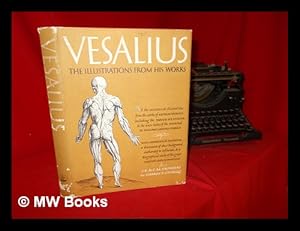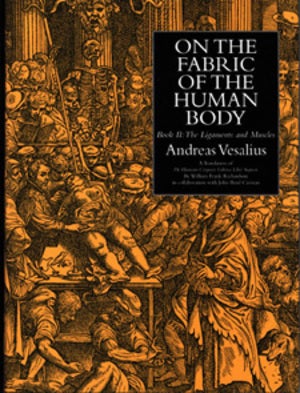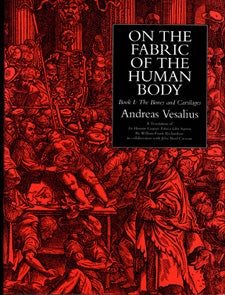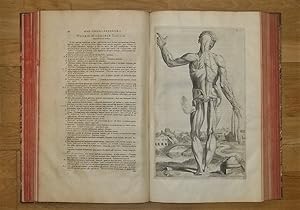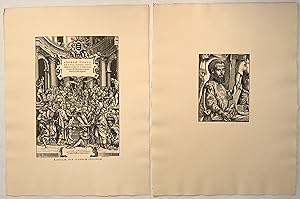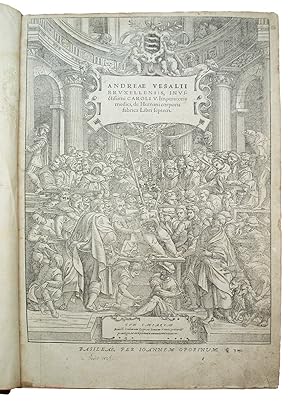Andreas Vesalius, First Edition (15 results)
Product Type
- All Product Types
- Books (15)
- Magazines & Periodicals
- Comics
- Sheet Music
- Art, Prints & Posters
- Photographs
- Maps
-
Manuscripts &
Paper Collectibles
Condition
Binding
Collectible Attributes
- First Edition
- Signed
- Dust Jacket (2)
- Seller-Supplied Images (10)
- Not Printed On Demand
Free Shipping
Seller Location
Seller Rating
-
Andreas Vesalius of Brussells" and "Vesalius and the Pulmonary Transit of Venous Blood" - Fist publication in Journal of the History of Medicine and Allied Sciences Vol. XIX No. 4
Published by Journal of the History of Medicine, New Haven, 1964
Seller: Bibliodisia Books, IOBA, MWABA, Chicago, IL, U.S.A.
Book First Edition
Paperback. Condition: Fine. Plate illoustration (illustrator). First Edition. Two important articles on Vesalius by noted scholars in the history of medicine, in the complete issue of this magazine. Laid in is a typed letter to members of the Journal from editor Elizabeth H. Thompsn. A fine, clean, unmarked copy. Scarce.
-
The Illustrations from the Works of Andreas Vesalius of Brussels
Published by World, 1950
First Edition
First printing thus. With annotations and translations, a discussion of the plates and their background, authorship and influence, and a biographical sketch of vesalius. Inked name, else fine in near fine, lightly edge worn dust jacket, in mylar cover,
-
The illustrations from the works of Andreas Vesalius of Brussels / with annotations and translations, a discussion of the plates and their background, authorship and influence, and a biographical sketch of Vesalius, by J.B. de C.M. Saunders and Charles D. O'Malley
Published by Cleveland : World Publishing Company, 1950
Seller: MW Books Ltd., Galway, Ireland
First Edition
First Edition. Good cloth copy in a good if somewhat edge-torn (with some loss) and dust-toned dust-wrapper, now mylar-sleeved. Remains quite well-preserved overall; tight, bright, clean and strong. Physical description; 248 pages : illustrations, portraits ; 31 cm. Contents; The title pages of the primary editions of the De Humani Corporis Fabrica -- Letter to Johannes Oporinus -- The plates from the De Humani Corporis Fabrica -- The plates from the Epitome of the De Humani Corporis Fabrica -- The Venesection Letter of 1539, plate -- The plates from the Tabulae Sex -- Plates showing evolution of the title page of the first edition of the De Humani Corporis Fabrica. Subjects; Vesalius, Andreas (1514-1564). Vesalius, Andreas (1514-1564) Illustrations. Anatomy, Artistic. Anatomists Belgium ; Biography. Human anatomy Belgium History. Medical illustration History. Anatomy history. Anatomie humaine ; Atlas. Anatomie humaine Ouvrages avant 1800. Vesalius, Andreas, (1514-1564) Individual works. Anatomy, Artistic ; Early works to 1800. Figure drawing ; Early works to 1800. Figure drawing. Anatomy, Artistic. Prints 16th century Flanders. Woodcuts. Human anatomy ; Atlases. Human anatomy ; Early works to 1800. Human form : anatomical drawing. Human Anatomy - Illustrations. Vesalius, Andreas (1514-1564). Genres; Atlas. Atlases. Early works to 1800. Early works. Scientific atlases. 2 Kg.
-
The illustrations from the works of Andreas Vesalius of Brussels / with annotations and translations, a discussion of the plates and their background, authorship and influence, and a biographical sketch of Vesalius, by J.B. de C.M. Saunders and Charles D. O'Malley
Published by Cleveland : World Publishing Company, 1950
Seller: MW Books, New York, NY, U.S.A.
First Edition
First Edition. Good cloth copy in a good if somewhat edge-torn (with some loss) and dust-toned dust-wrapper, now mylar-sleeved. Remains quite well-preserved overall; tight, bright, clean and strong. Physical description; 248 pages : illustrations, portraits ; 31 cm. Contents; The title pages of the primary editions of the De Humani Corporis Fabrica -- Letter to Johannes Oporinus -- The plates from the De Humani Corporis Fabrica -- The plates from the Epitome of the De Humani Corporis Fabrica -- The Venesection Letter of 1539, plate -- The plates from the Tabulae Sex -- Plates showing evolution of the title page of the first edition of the De Humani Corporis Fabrica. Subjects; Vesalius, Andreas (1514-1564). Vesalius, Andreas (1514-1564) Illustrations. Anatomy, Artistic. Anatomists Belgium ; Biography. Human anatomy Belgium History. Medical illustration History. Anatomy history. Anatomie humaine ; Atlas. Anatomie humaine Ouvrages avant 1800. Vesalius, Andreas, (1514-1564) Individual works. Anatomy, Artistic ; Early works to 1800. Figure drawing ; Early works to 1800. Figure drawing. Anatomy, Artistic. Prints 16th century Flanders. Woodcuts. Human anatomy ; Atlases. Human anatomy ; Early works to 1800. Human form : anatomical drawing. Human Anatomy - Illustrations. Vesalius, Andreas (1514-1564). Genres; Atlas. Atlases. Early works to 1800. Early works. Scientific atlases. 2 Kg.
-
Vesalius on the Human Brain. Introduction, Translation and Notes by Charles Singer.
Published by London: Oxford University Press for The Wellcome Historical Medical Museum, 1952., 1952
Seller: Ted Kottler, Bookseller, Redondo Beach, CA, U.S.A.
Book First Edition
Hardcover. Condition: Near Fine. No Jacket. 1st Edition. First Edition. xxvi; 151 pp; 48 figs. Original cloth. Ink stamp on flyleaf, else Near Fine, without dust jacket.
-
Apologia' from an Unfinished Bibliography of Vesalius." With an Introductory Note by W. W. Francis. Reprinted from Bulletin of the History of Medicine, Vol. VIII, no. 3, March 1940, pp. 381-91.
Publication Date: 1940
Seller: Scientia Books, ABAA ILAB, Arlington, MA, U.S.A.
Book First Edition
Soft cover. Condition: Very Good. 1st Edition. Original wrappers. Very Good. First Edition. Reprinted in Cushing's A Bio-Bibliography of Andreas Vesalius, pp. xv-xxiii.
-
The Bloodletting Letter of 1539. An Annotated Translation and Study of the Evolution of Vesalius's Scientific Development by J. B. de C. M. Saunders and Charles D. O'Malley.
Published by New York: Henry Schuman, no date.
Seller: Scientia Books, ABAA ILAB, Arlington, MA, U.S.A.
First Edition
94 pp. Original cloth. Very Good. This copy does NOT have any library markings. First Edition.
-
Vesalius The China Root Epistle
Published by Cambridge University Press, 2015
ISBN 10: 1107026350ISBN 13: 9781107026353
Seller: Collectors' Bookstore, Deurne, Belgium
Book First Edition
Condition: New. First Edition. First Edition thus. Vesalius The China Root Epistle by Andreas Vesalius. ISBN:9781107026353. Collectible item in excellent condition.
-
Epitome - De Humani corporis fabrica librorum - Facsimile of 1543
Published by Edition Medicina Rara, Stuttgart, 1970
Seller: Rare Books Honolulu, Honolulu, HI, U.S.A.
First Edition
Hardcover. Condition: Fine. Medicina Rara Stuttgart, 1970. Edition originale. De Humani corporis fabrica librorum Epitome. Luxusausgabe. Von Andreas Vesalius. Stuttgart 1970. 20 x 14.5 inches (39 x 52 cm) 24 pages, printed on Fabiano Rug, half-leather binding with leather corners, extra suite of 4 sheets with woodcut illustrations in a folder, numbered in Roman numerals, limited (500 copies). At the age of 23, the author became a professor of surgery in Padua with an obligation to teach anatomy and created his anatomical life's work during this time. With the work »De humani corporis fabrica« (»On the structure of the human body«), published in 1543, he represented the attitude against the general belief that only the human corpse offers a reliable way of finding out about the body structure and in this context he prepared the mortal remains of a criminal, the so-called "Vesal's skeleton", which is still preserved in the anatomical collection in Basel. The author made history and brought medicine as a natural science from ancient and medieval teachings into modern times. - Language : Latin text Codice Libreria 010681 Sample LXVI di C Size: 390 x520 mm. Fascsimile, De Luxe edition with additional prints.
-
On the Fabric of the Human Body. Vol. 3: The Veins and Arteries; The Nerves. Translated by William F. Richardson & John B. Carman
Published by Norman Publishing, San Francisco, 2002
ISBN 10: 0930405838ISBN 13: 9780930405830
Seller: Jeremy Norman's historyofscience, Novato, CA, U.S.A.
Book First Edition
Condition: New. First edition in English. Vol. III: Book III: The Veins and Arteries; Book IV: The Nerves . Translated by William Frank Richardson, M.A., Ph.D., in collaboration with John Burd Carman, B. Med. Sc., M.B.Ch.B., D. Phil. Vol. III: Book III: The Veins and Arteries; Book IV: The Nerves, contains a total of thirty-two chapters. Each book has a large, 18 x 12-inch, fold-out diagram detailing the veins and arteries and the nerves. xxxi, 286pp. 34 text illus., 2 large folding plates. 9" x 12". Cloth, dust jacket, 80-pound Mohawk Superfine Softwhite Eggshell acid-free paper. ISBN 0-930405-83-8. January 2003. Norman Anatomy Series, No. 3. Norman Landmarks Series, No. 4.
-
On the Fabric of the Human Body. Vol. 2: Ligaments & muscles. Translated by William F. Richardson and John B. Carman
Published by Norman, San Francisco, 1999
ISBN 10: 0930405757ISBN 13: 9780930405755
Seller: Jeremy Norman's historyofscience, Novato, CA, U.S.A.
Book First Edition
1st edition. Vesalius's De humani corporis fabrica libri septem, first published in 1543 is, along with William Harvey's classic work from 1628 on the discovery of the circulation of the blood, one of the two most famous books in the history of medicine. A cornerstone of the scientific revolution, published the same year as Copernicus's monumental treatise on the heliocentric universe, De humani corporis fabrica inaugurated the modern study of anatomy, leading to the eventual overturn of the Galenic system that had dominated medical science for fourteen centuries. Illustrated with woodcuts by artists in the school of Titian that have for centuries remained standard icons of medical literature, Vesalius's work is also a classic of sixteenth-century graphic art. When it was originally published in the mid-sixteenth century its Latin text guaranteed its accessibility to an international medical and scientific audience, all of whom had been educated to read and write Latin. Of course, fewer and fewer physicians and scientists read Latin today, and even professional classicists have reported considerable difficulty in interpreting Vesalius's technical Renaissance medical Latin. Although many editions, revisions, adaptations, and facsimiles of this work appeared over the centuries, remarkably it was never before now translated, except for fragments, into a modern language other than Russian (Moscow, 1950-1954). The Richardson and Carman translation supplies a modern, accessible version of this monumental work for the first time. Dr. Richardson and Professor Carman bring a lifetime of experience to the task of translating and presenting Vesalius's painstaking account of the fabric of the human body, having devoted many years to scholarly study of the Latin language (Dr. Richardson) and detailed human anatomy (Professor Carman). Book II: The Ligaments and Muscles, the second of seven books into which Vesalius's encyclopedic work is divided, contains 39 illustrations, including the series of dissected musclemen that remain the most f amous anatomical illustrations of all time. As in Book I: The Bones and Cartilages (published in 1998), all of Vesalius's marginal notes have been translated and the historiated initial letters have been reproduced. Book II is made up of 62 chapters and the majority of the chapters end with detailed translator's notes explaining subtleties in the translation. There are also indexes to the muscles, with detailed muscle grids; to the text; to people ad places; to words from Greek and Latin; and to the translator's notes. Informative and interpretive prefaces by the translator and anatomist provide details about the translation process of the book and the anatomy described therein. The lasting influences of both Vesalius's many discoveries and the dramatic woodcuts on the history of anatomy and the visual arts cannot be overestimated. The biographer of Picasso, John Richardson, points out that Vesalius's illustration were the direct inspiration for Picasso's famous painting The Dryad (1908) and other works. "How Picasso chanced upon the work of this body snatching anatomist, who saw his plates benefiting painters and sculptors as well as physicians and surgeons, I do not know. The most likely source would have been Apollinaire, a bibliophile with a taste for antiquarian medical books." (A Life of Picasso: 1907-1917. The Painter of Modern Life [New York: Random House, 1996]). As Dr. Richardson states in his preface to Book II, "The reader cannot but admire Vesalius's attention to detail, his astounding memory, his powers of observation and description, and his capacity for sheer hard work." Book II: The Ligaments and Muscles is a truly superb account of the muscles of the human body.
-
On the Fabric of the Human Body. Vol. I: Bones & Cartilages. Translated by William F. Richardson and John B. Carman
Published by Norman Publishing, San Francisco, 1998
ISBN 10: 0930405730ISBN 13: 9780930405731
Seller: Jeremy Norman's historyofscience, Novato, CA, U.S.A.
Book First Edition
1st edition. Vesalius's De humani corporis fabrica libri septem, first published in 1543 is, along with William Harvey's classic work from 1628 on the discovery of the circulation of the blood, one of the two most famous books in the history of medicine. A cornerstone of the scientific revolution, published the same year as Copernicus's monumental treatise on the heliocentric universe, De humani corporis fabrica inaugurated the modern study of anatomy, leading to the eventual overturn of the Galenic system that had dominated medical science for fourteen centuries. Illustrated with woodcuts by artists in the school of Titian that have for centuries remained standard icons of medical literature, Vesalius's work is also a classic of sixteenth-century graphic art. When it was originally published in the mid-sixteenth century its Latin text guaranteed its accessibility to an international medical and scientific audience, all of whom had been educated to read and write Latin. Of course, fewer and fewer physicians and scientists read Latin today, and even professional classicists have reported considerable difficulty in interpreting Vesalius's technical Renaissance medical Latin. Although many editions, revisions, adaptations, and facsimiles of this work appeared over the centuries, remarkably it was never before now translated, except for fragments, into a modern language other than Russian (Moscow, 1950-1954). The Richardson and Carman translation supplies a modern, accessible version of this monumental work for the first time. Dr. Richardson and Professor Carman bring a lifetime of experience to the task of translating and presenting Vesalius's painstaking account of the fabric of the human body, having devoted many years to scholarly study of the Latin language (Dr. Richardson) and detailed human anatomy (Professor Carman). Book I: The Bones and Cartilages, the first of the seven books in which Vesalius' encyclopedic work is divided, comprises approximately one-quarter, or 100,000 words, of the roughly 400,000 words that make up the entire Fabrica. The seventy-three illustrations in Book I and the historiated initial letters have been reproduced from the facsimile of the 1543 edition. The whole of Vesalius's text of Book I has been translated, including his marginal notes. The work begins with Vesalius's own Preface, the Publisher's Note to the Reader, and Vesalius's Letter to Johannes Oporinus, the printer and publisher of the original edition. At the end of each of the forty chapters in Book I there are detailed translator's notes explaining subtleties in the translation. There are also indexes to the text, to people and places, to words from languages other than English, and to the translator's notes. Informative and interpretive prefaces by the translators provide details about the history, anatomy, and translation process of the work. Book I: The Bones and Cartilages, which stands on its own as a major contribution to the history of medicine and of world culture, is the first installment of a forthcoming complete translation of Vesalius's Fabrica. Vesalius began his encyclopedia of anatomy with osteology because he rightly considered bones to be the foundation and framework supporting the human body. Book I: The Bones and Cartilages is unquestionably the first modern encyclopedic study of osteology. Series: Norman Anatomy Series, No. 1; Norman Orthopedics Series, No. 4; Norman Landmarks Series, No. 1.
-
Opera omnia anatomica & chirurgica. Cura Hermanni Boerhave & Bernhardi Siegfried Albini.
Published by Leiden, J. du Vivie et J. & H. Verbeek,, 1725
Book First Edition
2 Bde. 21 Bll., 572 S.; 4 Bll.; S. 577 - 684, 1 Bl., S. 685 - 1156, 26 Bll. mit 2 wdh. Kupfer-Titelvignetten und 38 Textkupfern. 1 Kupfertitel und 82 (12 gefalt.) Kupfertafeln (es fehlt das Kupfer-Porträt). Erste vollständige Gesamtausgabe der Werke des Andreas Vesalius. - Eales I, 133. Osler 579. Waller 9917; Lindeboom, Boerhaave 554: "fine edition".Choulant-Frank 183: "Die Holzschnitte des Hauptwerkes und der Epitome in Kupfer sehr schön nachgestochen.durch Jan Wandelaar und zwar in der Größe der Originale". - Famous collected edition of Vesalius`s works, issued by Hermann Boerhaave and Bernhard S. Albinus, with copperplate reproductions of the Vesalian woodblocks by Jan Wandelaar. The editors added explanations of Vesalius`s sixteenth-century anatomical nomenclature for their eighteenth-century readers, and prefaced the first volume with a biography of Vesalius, which Lindeboom has tentatively attributed to Boerhaave. The first volume contains a reprint of the 1555 edition of the Fabrica. The second volume contains the Epitome, the China-root epistle, the spurious Chirurgia magna, Fallopius`s letter to Manna, Vesalius`s Examen of Fallopius, and Cuneus`s Examen (curiously, the editors did not include the venesection letter). - Die Kupfer sind von 1 bis 79 numeriert, die Nummer 76 existiert als 76a, 76b und 76c, eine Tafel ist ohne Nummer. - Es fehlt das Kupfer-Porträt. - Vortitel und Titel von Bd. 1 mit hinterlegtem Ausschnitt (ohne Textberührung). Kupfertitel mit kl. hinterlegtem Eckabriß (ohne Bildberührung). Leicht gebräunt unjd stellenw. etw. fleckig. Schönes breitrandiges Exemplar. *** *** Copyright: Matthaeus TRUPPE Buchhandlung & Antiquariat - Stubenberggasse 7 - A-8010 Graz - ++43 (0)316 - 829552 *** *** Sprache: Deutsch Gewicht in Gramm: 9000 Gr.-Fol. Mod. HLdr. auf 5 Bünden mit Rückentitel und modernen Buntpapierbezügen ((etw. berieben).
-
Icones Anatomicae. Tabulae Selectae.
Published by (Munich: Bremer Press, 1934)., 1934
Book First Edition
Hardcover. Condition: Fine. 1st Edition. 1-50 unnumbered folios of 40 loose woodcut impressions. Large Folio (22 3/8 x 16 3/4 ). 40 sheets (21 3/4 x 16 1/4 ) printed on handmade, watermarked paper with deckle edges (plus 1 unprinted sheet). Presented in a light brown coarse-linen covered folio folder with beveled edges, cloth ties, and gilt-stamped titles front. The history and story of the Vesalius blocks which were cut using Vesalius original drawings and used in the printing of his monumental De humani corporis fabrica and his Epitome in 1543, is a story of epic proportions. The woodcuts were so massive and done with such precision and creativity, that for several hundred years they were widely attributed to the master Titian. Lost, refound, sold, lost again many times and finally rediscovered, for the final time, in 1932 by Samuel Lambert with the help of the renowned printer from the Bremer Press, Willy Wiegand, in the attic of the LMU Munich Library in a crate containing 230 blocks. Perhaps the most iconic and important block found was the title-page image of Vesalius conducting a dissection of a woman before a theater of 75 observing individuals believed to be the first time a public dissection was depicted. Wiegand and the Bremer Press were widely considered Europe s finest printer and press and were chosen to publish a contemporary atlas pulled from all of the Vesalius blocks. The difficulty of this undertaking was compounded by the fact that almost all of the blocks were warped from age and improper storage, and also by the extreme financial precarious state of Germany in general and the Press in particular. The brilliant success of the published works bespeaks deeply of the skill of the printer Wiegand; the Bremer Press impressions are widely considered to be the finest ever done from original Renaissance blocks. The subsequent fate of the Press and blocks is well known: the Press went bankrupt shortly after publication and the blocks were destroyed on 16 July 1944 by a bombing run by the U. S. Air Force which sadly hit the Munich Library were the blocks were stored in a supposedly bomb-proof basement. Bremer Press printed 615 numbered copies of the atlas and another 110 without text. In addition there were fifty unbound Tabula selecta of forty impressions presented in a linen covered folder. This is one of those folios. All 40 impressions are present and in bright, fine condition. Contained in the 40 impressions are the two title pages dissecting theater images, musculature, craniums, circulatory system, full male and female frontal nudes, et al. The folder is lacking the original ties and there is light soil but overall very bright. On the cover verso is a small but nice association bookplate from the library of G. S. T. Cavanagh, who was a noted Vesalius scholar and rare medical book librarian, and whose Sacrum Press published in 1996 The Panorama of Vesalius: A Lost Design from Titian s Studio. Undoubtedly most of the 50 sets have long since been broken up and the presence of a complete set is very scarce indeed.
-
De humani corporis fabrica libri septem
Published by Per Ioannem Oporinum, Basel, 1555
Seller: Heritage Book Shop, ABAA, Beverly Hills, CA, U.S.A.
First Edition
Basel: Per Ioannem Oporinum, [1555]. Second and best folio edition (first published in 1543) of the most important anatomical treatise of the sixteenth century. With author's final additions and corrections as well as a renewed woodcut title-page and and initials. Large folio (16 x 10 7/8 inches; 407 x 275 mm). [12], 504, [1, folding table paginated "505"], [1, unpaginated leaf of figures to be superimposed], 507-824, [48] pp. Collation: a-z6 A-V6 X2 (including fold-out sheet) Y-Z6 aa6 bb8 (bb 6-7 is fold-out sheet) cc- zz6 Aa8 Bb-Ee6. Complete with woodcut title, woodcut portrait of the author on a6 verso, numerous woodcut illustrations (including nineteen full-page anatomical illustrations), two folding tables with woodcut diagrams, woodcut printer's device on verso of final leaf, and seven-to twelve-line historiated woodcut initials. Full 17th century paneled calf, boards paneled in gilt. Rebacked with early spine laid- down. Spine stamped in gilt. Red Morocco spine label, lettered in gilt. With some expert restoration to folding plates. A small professional repair to page 203. Some minor marginal staining to pages 509-566 and 794 through the end. A handsome copy with crisp clean pages. Overall a very good copy. "This edition contains Vesalius's final revisions of the text, along with significant typographical improvements and refinements. Oporinus set the second folio edition in larger type (forty-nine instead of fifty-seven lines per page), which required recutting of all the small initials letters so that they could fit seven lines of the new type. Oporinus also used heavier and finer paper for the second edition, and improved the presswork so that the second edition is a superior example of bookmaking" (Norman Library). Aside from the renewed engraved title-page and initials, this second edition (1555) used the same plates as the first edition. The woodblocks survived in Germany until the Second World War during which they were destroyed while in the Munich Library. Before they were destroyed in the war, the Bremer press published their 1935 Andreae Vesalii Bruxellensis Icones Anatomicae edition useing the original blocks from 1543 and 1555, and interspersed passages of text, the "key" to the illustrations from the 1555 (present) edition. "The young Vesalius, with an iconoclastic zeal characteristic of the sixteenth century, and a forcible style all his own, endeavoured to do all that Galen had done and to do it better. The result was â The Structure of the Human Body', published when he was twenty-nine; a complete anatomical and physiological study of every part of the human body, based on first-hand examination and his five years' experience as public prosector in the medical school at Padua. The five books deal with the bones and muscles, blood vessels, nerves, abdominal viscera, thoracic organs and the brain. Galen was not merely improved upon: he was superseded; and the history of anatomy is divided into two periods, pre-Vesalian and post-Vesalian. The Fabrica, a handsomely printed folio, is remarkable for its series of magnificent plates, which set new technical standards of anatomical illustrations, and indeed of book illustration in general. They have generally been ascribed to an artist of Titian's school, long (but no longer) thought to be Jan Stephen van Calcar (1499-c. 1550). Vesalius's was the most splendid and the most comprehensive of a large number of anatomical treatises of the sixteenth century. The second edition (1555) used the same plates (the woodblocks indeed survived in Germany until the Second World War) but contains minor variations in the text. No other work of the sixteenth century equals it" (Printing and the Mind of Man ). Adams V605.Choulant-Frank, pp. 181-182. Cushing, Vesalius, VI.A.-3. Garrison and Morton 377. NLM/Durling 4579. Norman Library 2139. Osler 568. Waller 9901. Wellcome 6562. Printing and the Mind of Man 71 (describing the 1543 first folio edition). HBS 68434. $105,000.



